
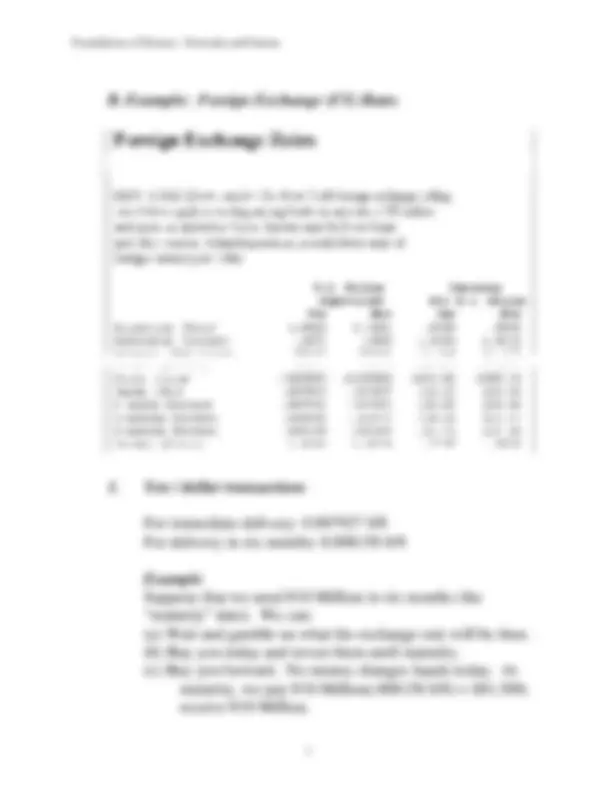
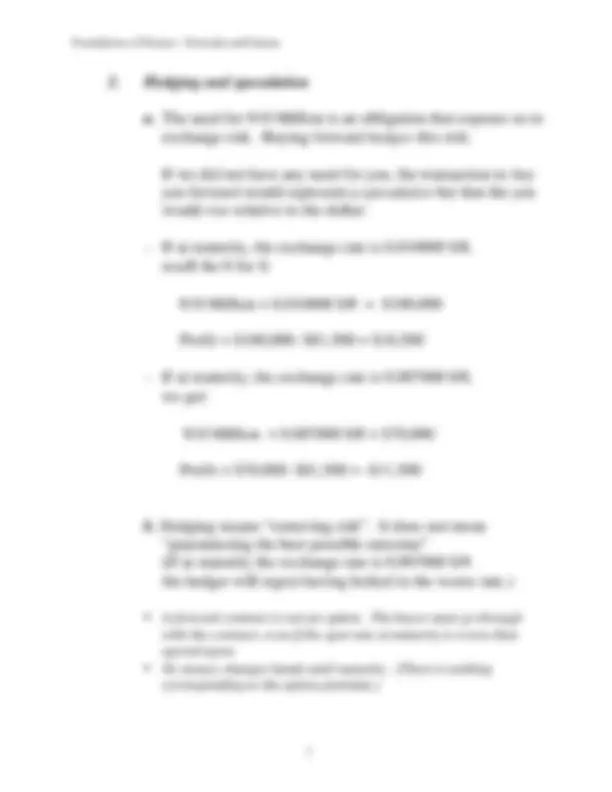
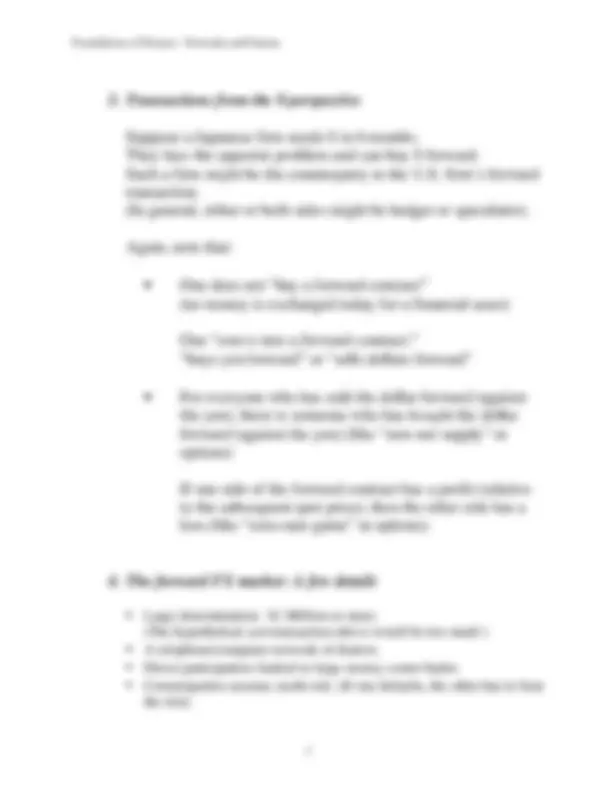
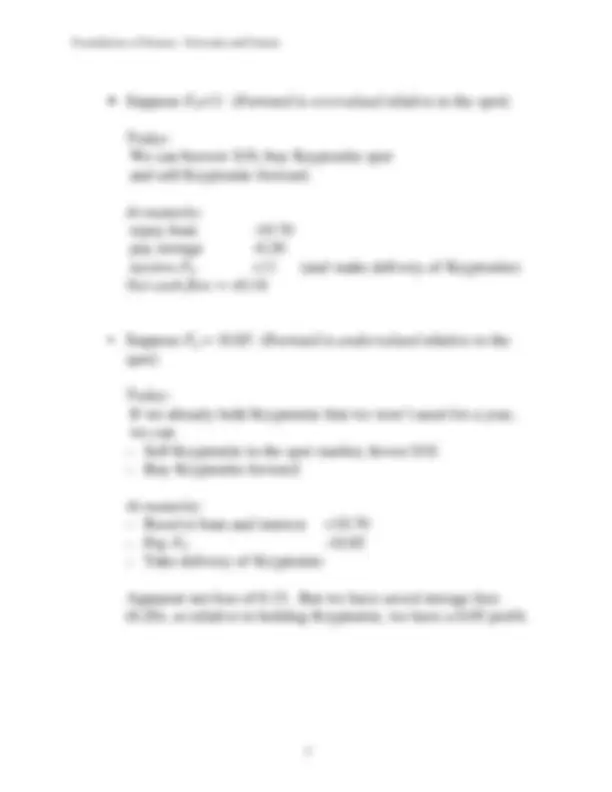
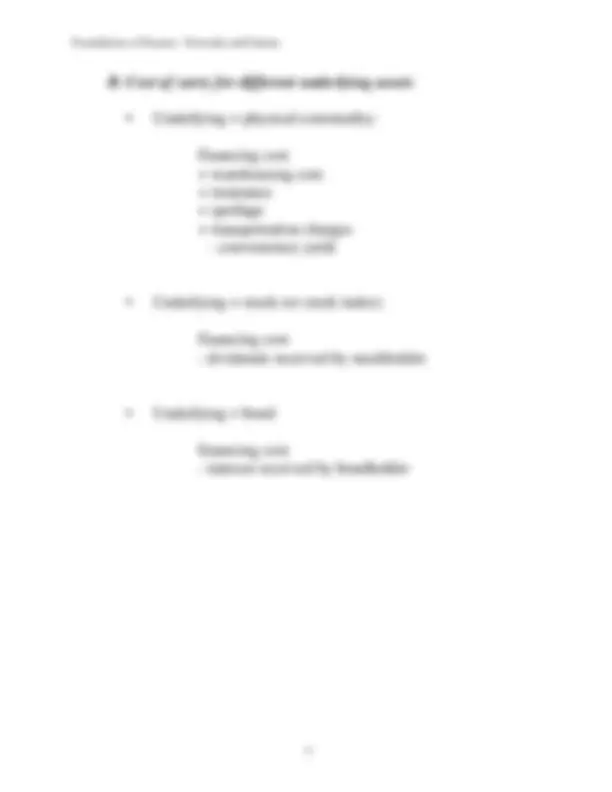
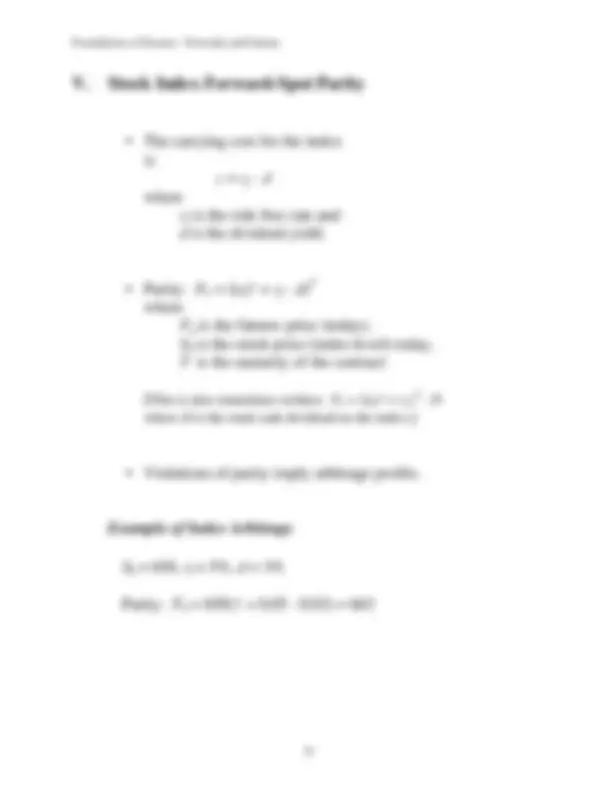
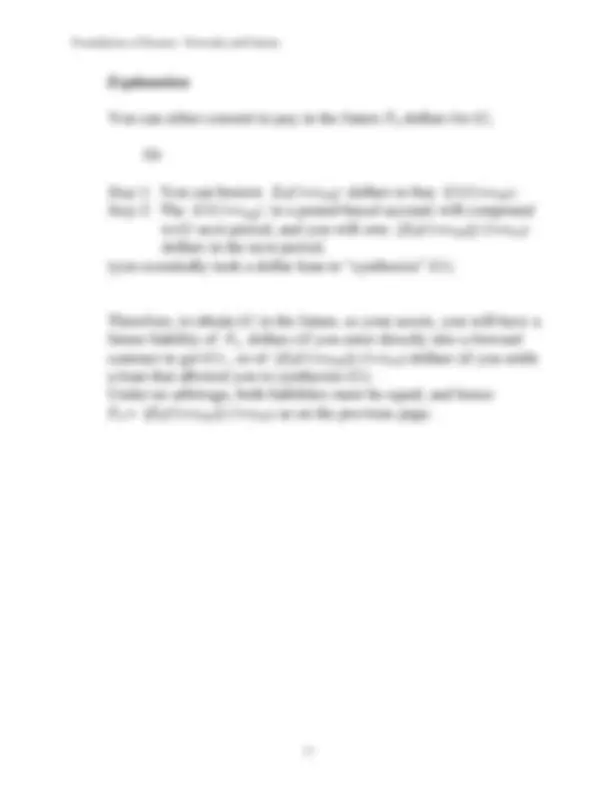
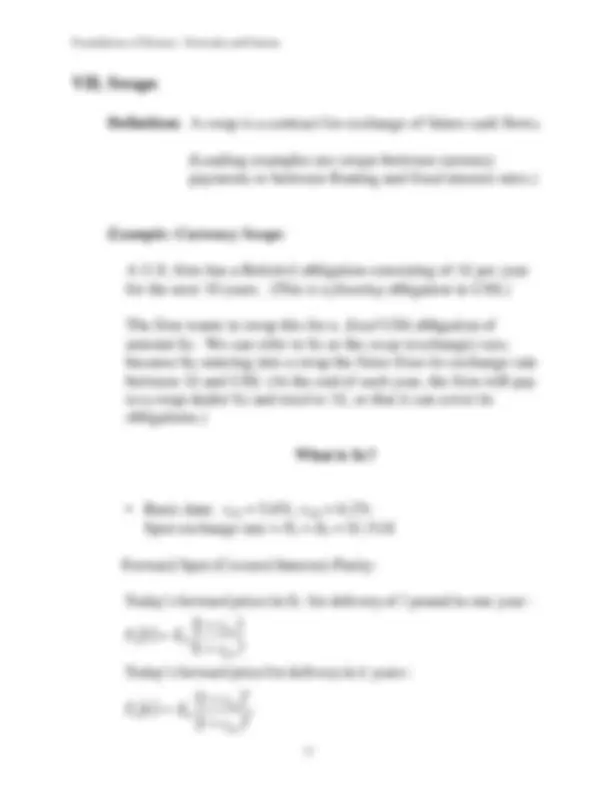
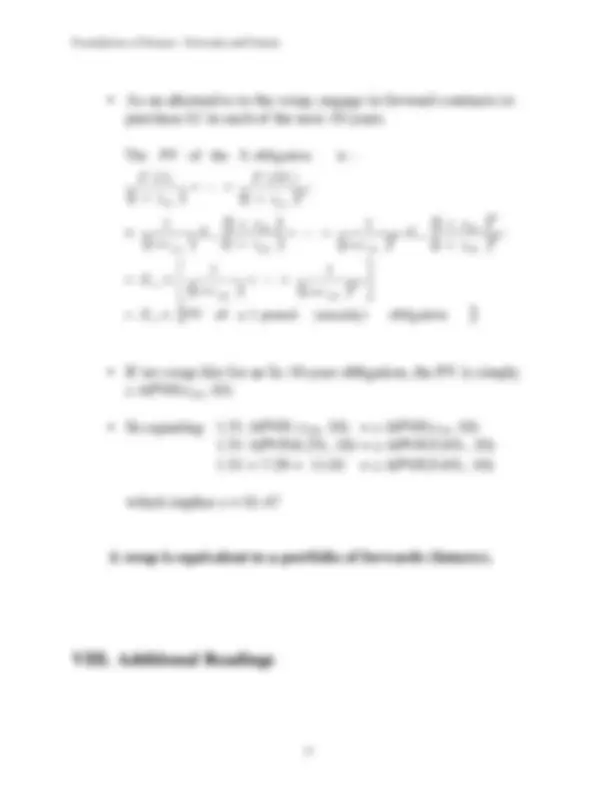


Study with the several resources on Docsity

Earn points by helping other students or get them with a premium plan


Prepare for your exams
Study with the several resources on Docsity

Earn points to download
Earn points by helping other students or get them with a premium plan
Community
Ask the community for help and clear up your study doubts
Discover the best universities in your country according to Docsity users
Free resources
Download our free guides on studying techniques, anxiety management strategies, and thesis advice from Docsity tutors
An in-depth analysis of forward and futures contracts, including definitions, examples, and the concept of forward-spot parity. various underlying assets such as commodities, stocks, and bonds, and discusses the cost of carry for each. It also explores stock index arbitrage and foreign exchange forward-spot parity.
Typology: Study Guides, Projects, Research
1 / 15

This page cannot be seen from the preview
Don't miss anything!










Foundations of Finance: Forwards and Futures Prof. Alex Shapiro
Lecture Notes 16
Buzz Words: Hedgers, Speculators, Arbitrageurs, Cost of Carry, Convenience Yield, Stock Index Arbitrage, Floating vs. Fixed Rates
BKM, Chapter 22, Section 4.
BKM, Chapter 23.
BKM, Chapter 16, Section 5.
Suggested Problems, Chapter 22: 13; Chapter 23: 3, 25.
A. Definition
A forward contract on an asset is an agreement between the buyer and seller to exchange cash for the asset at a predetermined price (the forward price) at a predetermined date (the settlement date).
2. Hedging and speculation
a. The need for ¥10 Million is an obligation that exposes us to exchange risk. Buying forward hedges this risk.
If we did not have any need for yen, the transaction to buy yen forward would represent a speculative bet that the yen would rise relative to the dollar:
¥10 Million × 0.010000 $/¥ = $100,
Profit = $100,000- $81,500 = $18,
¥10 Million × 0.007000 $/¥ = $70,
Profit = $70,000- $81,500 = -$11,
b. Hedging means “removing risk”. It does not mean “guaranteeing the best possible outcome” (If at maturity the exchange rate is 0.007000 $/¥ the hedger will regret having locked in the worse rate.)
3. Transactions from the ¥ perspective
Suppose a Japanese firm needs $ in 6 months. They face the opposite problem and can buy $ forward. Such a firm might be the counterparty to the U.S. firm’s forward transaction. (In general, either or both sides might be hedger or speculator).
Again, note that:
One “ enters into a forward contract:” “buys yen forward” or “sells dollars forward”
If one side of the forward contract has a profit (relative to the subsequent spot price), then the other side has a loss (like “zero-sum game” in options).
4. The forward FX market: A few details - Large denomination: $1 Million or more. (The hypothetical yen transaction above would be too small.) - A telephone/computer network of dealers. - Direct participation limited to large money center banks. - Counterparties assume credit risk. (If one defaults, the other has to bear the risk)
A. Forward-spot parity is a valuation principle for forward contracts.
Often approximately correct for futures contracts as well.
F 0 forward price P 0 spot price
The idea : “buying forward” is equivalent to “buying now and storing/carrying the underlying”
The cost of carry reflects:
Example for a Commodity contract
Kryptonite is $10 per gram in the spot market. It will cost 2% of its value to store a gram for one year. The annual interest rate is 7%.
Therefore: The percentage cost of carry is c = 9%
Parity implies F 0 = 10(1.09) = 10.
Today : We can borrow $10, buy Kryptonite spot and sell Kryptonite forward.
At maturity : repay loan -10. pay storage -0. receive F 0 +11 (and make delivery of Kryptonite) Net cash flow = +0.
Today : If we already hold Kryptonite that we won’t need for a year, we can
At maturity :
Apparent net loss of 0.15. But we have saved storage fees (0.20), so relative to holding Kryptonite, we have a 0.05 profit.
[This is also sometimes written: F 0 = S 0 ( 1 + r (^) f ) T^ - D where D is the total cash dividend on the index.]
Example of Index Arbitrage
S 0 = 650, r (^) f = 5%, d = 3%
Parity: F 0 = 650(1 + 0.05 - 0.03) = 663
Arbitrage : Borrow $650 + Buy index - 650 Short the futures 0 Net cash flow 0
“Unwind” at maturity : Collect divs [3%(650)] 19. Sell stock (index) + S (^) T Settle futures -( S (^) T - 665) Repay loan [1.05x650] - 682. Total +
spot.
Arbitrage : Long futures 0 Short stock + Invest short-sale proceeds - 650 Net cash flow 0
At maturity : Settle futures ( S (^) T - 660) Pay dividends [3%(650)] -19. Repurchase stock - S (^) T Investment matures 682. Total 3
Explanation
You can either commit to pay in the future F 0 dollars for £1,
Or
Step 1: You can borrow E 0 /(1+ r UK) dollars to buy £1/(1+ r UK). Step 2: The £1/(1+ r UK) in a pound-based account will compound to £1 next period, and you will owe [ E 0 /(1+ r UK)] (1+ r US) dollars in the next period. (you essentially took a dollar loan to “synthesize” £1).
Therefore, to obtain £1 in the future, as your assets, you will have a future liability of F 0 dollars (if you enter directly into a forward contract to get £1) , or of [ E 0 /(1+ r UK)] (1+ r US) dollars (if you settle a loan that allowed you to synthesize £1). Under no arbitrage, both liabilities must be equal, and hence F 0 = [ E 0 /(1+ r UK)] (1+ r US) as on the previous page.
Definition: A swap is a contract for exchange of future cash flows.
(Leading examples are swaps between currency payments or between floating and fixed interest rates.)
Example: Currency Swaps
A U.S. firm has a British £ obligation consisting of 1£ per year for the next 10 years. (This is a floating obligation in US$.)
The firm wants to swap this for a fixed US$ obligation of amount $ x. We can refer to $ x as the swap (exchange) rate , because by entering into a swap the firms fixes its exchange rate between 1£ and US$. (At the end of each year, the firm will pay to a swap dealer $ x and receive 1£, so that it can cover its obligations.)
What is $ x****?
Forward Spot (Covered Interest) Parity:
( )
( ) ( )
( )
( ) ( (^) UK ) k
k US
UK
US
r
r F k E
k
r
r F E
Today’sforwardpricefordeliveryin years:
Today’sforwardprice(in$) fordeliveryof 1 poundinoneyear:
0 0
0 0